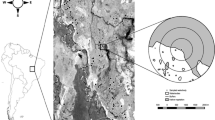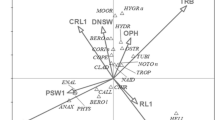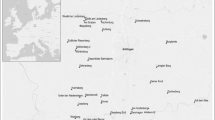Abstract
Habitat-based surrogates are a low cost alternative to intensive biodiversity surveys, though they have been poorly investigated in semi-arid ecosystem compared to others such as temperate woodlands. In this study we tested potential habitat-based surrogates of invertebrate richness in a semi-arid rangeland in northwest Australia. Potential surrogates were: distance from artificial watering-point; soil hardness; habitat complexity; and individual complexity components. Generalised additive models (GAMs) were used to relate abundance and richness of selected invertebrates with environmental factors and cluster analysis was used to examine similarity in species composition. The most frequently selected factor was soil hardness, but taxa varied as to whether biodiversity was higher in soft or hard soils. Where distance from watering-point was an important predictor, there were generally higher abundances and richness closer to watering-points than further away. Abundance and species richness could be partially explained using individual complexity components, but relationships were weak and there were no consistent trends among taxa. Therefore, although habitat complexity has been correlated with species richness under some circumstances, our results cast doubt on the generality of this relationship. There are also dangers in assuming that all taxa respond in a manner similar to indicator taxa, as we observed that different taxa had higher richness at opposite extremes of some environmental gradients. Grazing may have a negative impact on biodiversity in some environments, but in regions where water is limiting, the net effect may be positive due to the creation of waterholes.




Similar content being viewed by others
References
Andersen AN (1997) Using ants as bioindicators, multiscale issues in ant community ecology. Conserv Ecol 1(1):8. http://www.ecologyandsociety.org/vol1/iss1/art8/. Cited 12 Dec 2007
Bestelmeyer BC, Wiens JA (1996) The effects of land use on the structure of ground-foraging ant communities in the Argentine Chaco. Ecol Appl 6:1225–1240. doi:10.2307/2269603
Bestelmeyer BC, Wiens JA (2001) Ant biodiversity in semiarid landscape mosaics: the consequences of grazing vs. natural heterogeneity. Ecol Appl 11(4):1123–1140. doi:10.1890/1051-0761(2001)011[1123:ABISLM]2.0.CO;2
Caro TM, O’Doherty G (1999) On the use of surrogate species in conservation biology. Conserv Biol 13:805–814. doi:10.1046/j.1523-1739.1999.98338.x
Catling PC, Burt RJ (1995) Studies of ground-dwelling mammals of eucalypt forests in south-eastern New South Wales: the effect of environmental variables on distribution and abundance. Wildl Res 22:669–685. doi:10.1071/WR9950669
Cook RD (1977) Detection of influential observation in linear regression. Technometrics 19:15–18. doi:10.2307/1268249
Crawford CS (1988) Surface-active arthropods in a desert landscape: influences of microclimate, vegetation, and soil texture on assemblage structure. Pedobiologia (Jena) 3:373–385
di Castri F, Robertson J, Vernhes J, Younes T (1992) Inventorying and monitoring biodiversity. Biol Int 27:1–27
Ferrier S, Guisan A (2006) Spatial modelling of biodiversity at the community level. J Appl Ecol 43:393–404. doi:10.1111/j.1365-2664.2006.01149.x
Ferrier S, Manion G, Elith J, Richardson K (2007) Using generalized dissimilarity modeling to analyse and predict patterns of beta diversity in regional biodiversity assessment. Divers Distrib 13:252–264
Fisher A, Hunt L, James C et al (2004) Review of total grazing pressure management issues and priorities for biodiversity conservation in rangelands: a resource to aid NRM planning. Desert knowledge CRC and tropical savannas management. CRC, Alice Springs
Fleishman E, Noss RF, Noon BR (2005) Utility and limitations of species richness metrics for conservation planning. Ecol Indic 6(3):543–553. doi:10.1016/j.ecolind.2005.07.005
Fraser SEM, Dytham C, Mayhew PJ (2007) Determinants of parasitoid abundance and diversity in woodland habitats. J Appl Ecol 44(2):352–361. doi:10.1111/j.1365-2664.2006.01266.x
Gaston KJ, Blackburn TM (1995) Mapping biodiversity using surrogates for species richness: macro-scales and new world birds. Proc R Soc Lond B Biol Sci 262(1365):335–341. doi:10.1098/rspb.1995.0214
Gillison AN, Jones DT, Susilo F-X et al (2003) Vegetation indicates diversity of soil macroinvertebrates: a case study with termites along a land-use intensification gradient in lowland Sumatra. Org Divers Evol 3(2):111–126. doi:10.1078/1439-6092-00072
Grove S (2002) Tree basal area and dead wood as surrogate indicators of saproxylic insect faunal integrity: a case study from the Australian lowland tropics. Ecol Indic 1:171–188. doi:10.1016/S1470-160X(01)00016-4
Hansen RA (2000) Effects of habitat complexity and composition on a diverse litter microarthropod assemblage. Ecology 81:1120–1132
Hastie T, Tibshirani R (1990) Generalized additive models. Chapman and Hall, New York
Hoffman BD (2000) Changes in ant species composition and community organization along grazing gradients in semi-arid rangelands of the northern territory. Rangeland J 22(2):171–189. doi:10.1071/RJ0000171
Hughes JB, Daily GC, Ehrlich PR (2000) Conservation of insect diversity: a habitat approach. Conserv Biol 14(6):1788–1797. doi:10.1046/j.1523-1739.2000.99187.x
James CD, Landsberg J, Morton SR (1999) Provision of watering points in the Australian arid zone: a review of effects on biota. J Arid Environ 41:87–121. doi:10.1006/jare.1998.0467
Jiménez-Valverde A, Lobo J (2007) Determinants of local spider (Araneidae and Thomisidae) species richness on a regional scale: climate and altitude vs. habitat structure. Ecol Entomol 32(2):113–122
Kerr JT, Sugar A, Packer L (2000) Indicator taxa, rapid biodiversity assessment, and nestedness in an endangered ecosystem. Conserv Biol 14(6):1726–1734. doi:10.1046/j.1523-1739.2000.99275.x
Lal R (1991) Soil conservation and biodiversity. In: Hawkesworth DL (ed) The biodiversity of microorganisms and invertebrates: its role in sustainable agriculture. CAB International, University of Arizona Press, pp 89–103
Lassau SA, Hochuli DF (2005) Wasp community responses to habitat complexity in Sydney sandstone forests. Aust Ecol 30(2):179–187. doi:10.1111/j.1442-9993.2005.01435.x
Lassau SA, Cassis G, Flemons PKJ et al (2005) Using high-resolution multi-spectral imagery to estimate habitat complexity in open-canopy forests: can we predict ant community patterns? Ecography 28(4):495–504. doi:10.1111/j.0906-7590.2005.04116.x
Ludwig JA, Eager RW, Williams RJ et al (1999) Declines in vegetation patches, plant diversity, and grasshopper diversity near cattle watering-points in the Victoria River district, Northern Australia. Rangeland J 21(1):135–149. doi:10.1071/RJ9990135
MacArthur RH, MacArthur HJ (1961) On bird species diversity. Ecology 42(3):594–598. doi:10.2307/1932254
Majer JD, Nichols OG (1998) Long-term recolonization patterns of ants in western Australian rehabilitated bauxite mines with reference to their use as indicators of restoration success. J Appl Ecol 35:161–182. doi:10.1046/j.1365-2664.1998.00286.x
McGeoch MA (1998) The selection, testing and application of terrestrial invertebrates as bioindicators. Biol Rev Camb Philos Soc 73:181–201. doi:10.1017/S000632319700515X
Noss RF (1990) Indicators for monitoring biodiversity, a hierarchical approach. Conserv Biol 4:355–364. doi:10.1111/j.1523-1739.1990.tb00309.x
Osborn TG, Wood JG, Paltidge TB (1932) On the growth and reaction to grazing of the perennial saltbush (Atriplex vesicarium). An ecological study of the biotic factor. Proc Linn Soc N S W 57:377–402
Perfecto I, Snelling R (1995) Biodiversity and the transformation of a tropical agroecosystem: ants in coffee plantations. Ecol Appl 5:1084–1097. doi:10.2307/2269356
Perrings C, Walker BW (1995) Biodiversity loss and the economics of discontinuous change in semiarid rangelands. In: Perrings C, Mäler K, Folke C, Holling CS, Jansson B (eds) Biodiversity loss economic and ecological issues. Cambridge University Press, Cambridge, pp 190–212
Pringle HJR, Landsberg J (2004) Predicting the distribution of livestock grazing pressure in rangelands. Austral Ecol 29:31–39. doi:10.1111/j.1442-9993.2004.01363.x
Quinn MA, Kepner RL, Walgenbach DD et al (1991) Habitat characteristics and grasshopper community dynamics on mixed-grass rangeland. Can Entomol 123(1):89–105
Samways MJ (2007) Insect conservation: a synthetic management approach. Annu Rev Entomol 52(1):465–487. doi:10.1146/annurev.ento.52.110405.091317
Sauberer N, Zulka KP, Abensperg-Traun M et al (2004) Surrogate taxa for biodiversity in agricultural landscapes of eastern Austria. Biol Conserv 117:181–190. doi:10.1016/S0006-3207(03)00291-X
Schell SP, Lockwood JA (1997) Spatial analysis of ecological factors related to rangeland grasshopper (Orthoptera: Acrididae) outbreaks in Wyoming. Environ Entomol 26(6):1343–1353
Sharley DJ, Hoffmann AA, Thomson LJ (2008) The effects of soil tillage on beneficial invertebrates within the vineyard. Agric For Entomol 10(3):233–243. doi:10.1111/j.1461-9563.2008.00376.x
Stapp P (1997) Microhabitat use and community structure of darkling beetles (Coleoptera: Tenebrionidae) in shortgrass prairie: effects of season, shrub cover, and soil type. Am Midl Nat 137:298–311. doi:10.2307/2426849
Stoms DM, Comer PJ, Crist PJ, Grossman DH (2005) Choosing surrogates for biodiversity conservation in complex planning environments. J Conserv Plann 1:44–63
Tews J, Brose U, Grimm V et al (2004) Animal species diversity driven by habitat heterogeneity/diversity: the importance of keystone structures. J Biogeogr 31:79–92
Whitford WG, Van Zee J, Nash MS et al (1999) Ants as indicators of exposure to environmental stressors in North American desert grasslands. Environ Monit Assess 54:143–171. doi:10.1023/A:1005858918860
Wilkie L, Cassis G, Gray M (2003) A quality control protocol for terrestrial invertebrate biodiversity assessment. Biodivers Conserv 12:99–106. doi:10.1023/A:1021242329800
Acknowledgments
This research was undertaken as part of the Australian Museum–Rio Tinto partnership and funded through the Rio Tinto WA Future Fund. We thank M. Elliott, L. Kampen and M. Bulbert for help with fieldwork. Thanks to D. Smith (ants), S. Ginn (wasps, flies) and G. Brown (beetles) for taxonomic sorting and/or identifications, and Dr C. Reid, Dr D. Bickel, Dr D. McAlpine, and Dr S. McEvey for their taxonomic advice. We also thank two anonymous reviewers for useful comments on an earlier draft.
Author information
Authors and Affiliations
Corresponding author
Rights and permissions
About this article
Cite this article
Gollan, J.R., Ashcroft, M.B., Cassis, G. et al. Testing common habitat-based surrogates of invertebrate diversity in a semi-arid rangeland. Biodivers Conserv 18, 1147–1159 (2009). https://doi.org/10.1007/s10531-008-9504-3
Received:
Accepted:
Published:
Issue Date:
DOI: https://doi.org/10.1007/s10531-008-9504-3




